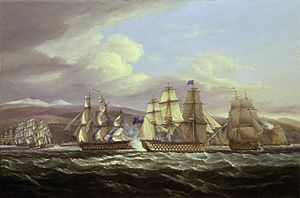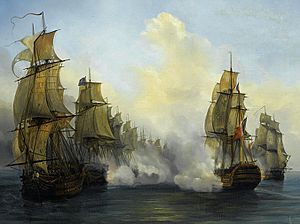Action of 5 November 1813 facts for kids
Quick facts for kids Action of 5 November 1813 |
|||||||
|---|---|---|---|---|---|---|---|
| Part of the Napoleonic Wars | |||||||
 The Blockade of Toulon, 1810-14: Pellew's Action, 5 November 1813, Thomas Luny |
|||||||
|
|||||||
| Belligerents | |||||||
| Commanders and leaders | |||||||
| Strength | |||||||
| 13 ships of the line | 5 ships of the line 4 frigates |
||||||
| Casualties and losses | |||||||
| 15 killed and wounded | 17 wounded | ||||||
The Action of 5 November 1813 was a short naval battle during the Napoleonic Wars. It happened near the French port of Toulon. In this clash, a part of the British fleet, led by Vice-Admiral Sir Edward Pellew, fought against a French force. The French ships were under the command of Rear-Admiral Julien Cosmao-Kerjulien. Neither side won a clear victory.
Contents
Why the Battle Happened
The Blockade of Toulon
For many years, the French navy's main fleet was stuck in their port at Toulon. This was because the British navy was blockading the port. A blockade means that enemy ships wait outside a port to stop other ships from leaving or entering.
The French commander, Vice-Admiral Maxime Julien Émeriau de Beauverger, would sometimes take his ships out for practice. He tried to do this when the British fleet was not around. He wanted to avoid fighting the British ships led by Vice-Admiral Sir Edward Pellew.
Pellew's Strategy
Sir Edward Pellew hoped to trick the French fleet into coming out. He wanted to cut them off from their port and force a big battle. So, he kept most of his large ships a bit further away from Toulon. He used a smaller group of ships, called an inshore squadron, to watch the port closely. These were mostly 74-gun ships, which were powerful warships.
A Change in the Weather
In late October 1813, strong storms pushed both the British inshore squadron and the main fleet away from their usual spots. Vice-Admiral Émeriau saw this as a chance. He decided to take his fleet out for exercises near Cape Sicié.
On the morning of 5 November, the French fleet sailed out. It had about 12 to 14 large warships and several smaller frigates. A strong wind helped them move towards their practice area.
The British Spot the French
The British inshore squadron, led by Captain Henry Heathcote, had just returned to its position the night before. Sir Edward Pellew's main fleet was still some distance away. Captain Heathcote, with his four 74-gun ships, watched the French.
Suddenly, around 11:30 am, the wind changed direction. Émeriau became worried. He saw the British ships and decided to stop the exercises. He ordered his fleet to return to Toulon.
The Chase Begins
The French ships that were at the back of the fleet, led by Rear-Admiral Julien Cosmao-Kerjulien, were now in a difficult spot. They had to sail against the wind to get back to port. Captain Heathcote quickly saw an opportunity. He ordered his squadron to attack the French ships at the rear.
The Battle Unfolds
Captain Heathcote, on his ship HMS Scipion, led the attack. At 12:34 pm, his ship sailed past the French rear, firing its cannons. The other British ships followed. One more British ship, HMS Pompee, joined them from Pellew's main fleet.
The British ships then turned around and sailed back, firing their cannons again at the French ships trying to escape. Around 1:00 pm, the first ships from Pellew's main fleet arrived. These included HMS Caledonia, HMS San Josef, and HMS Boyne. They also started firing at the last French ship, the Wagram.
The British ships kept turning and firing. But the wind helped Cosmao-Kerjulien's squadron. They managed to get close enough to Toulon to be protected by the shore batteries. These were cannons on land that could fire at enemy ships.
Aftermath of the Battle
The battle was short, and neither side suffered heavy losses.
- The British had 12 men wounded by French fire. One man died and two were wounded in accidents on their own ships. So, 15 British sailors were hurt in total.
- The British ship Caledonia was hit a few times. Its main mast was damaged, and its hull (the body of the ship) had some holes. Some ropes and small boats were also destroyed.
- The French had 17 men wounded. Most of these were on the ship Agamemnon, which also had damage to its masts, hull, and rigging (the ropes and sails).
- The French ship Borée had its steering wheel shot off. Two French frigates, Pénélope and Melpomène, also had damage to their sails and masts.
After the battle, Pellew sailed to Menorca. He left only a few ships to continue the blockade. But Émeriau, the French commander, decided not to come out again.
See Also
- List of shipwrecks in 1813
Images for kids



